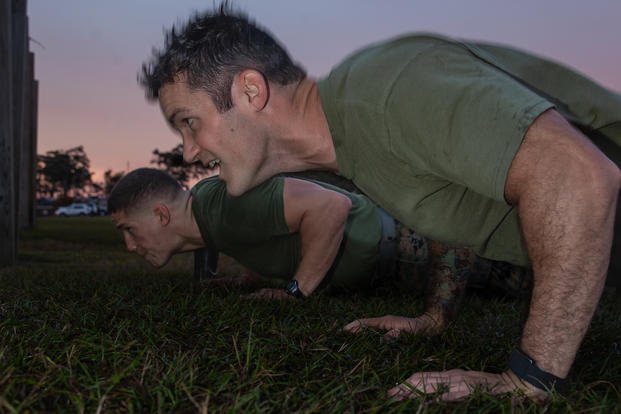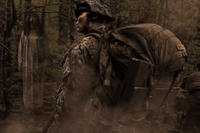Being a Marine requires a level of fitness the average military member does not have. The fitness tests are more difficult and the training is challenging, requiring Marines to stay in above-average condition to perform their jobs.
The Marine Physical Fitness Test (PFT), for instance, consists of pull-ups, a plank and three-mile run. The run is 1-1.5 miles longer than the other services, and pull-ups are the toughest calisthenics exercise tested in the U.S. military. Then, there is the Marine Corps Combat Fitness Test (CFT), a more intense and job-related version of a test that requires a fast 800-meter run, a series of agility movements carrying gear, dragging people, moving ammo cans and throwing grenades (for accuracy). The Marine Corps obstacle course is another test Marines have to master as well -- and this is just to be a Marine.
The Marine Force Recon standards and testing are a level greater. Just to get accepted and complete Recon training, you should prepare yourself for two fitness tests:
The RTAP is the selection program you are working so hard to enter. If you do not pass this course and the tests throughout, you will not be eligible for the Basic Reconnaisance Course (BRC) to become a Recon Marine.
The RPAT and the RTAP test are next-level fitness tests as they add more exercises, swimming and rucking to the standard Marine fitness tests. If you do not pass the RPAT, your Recon journey ends before it even starts, so get good at the following events of the RPAT:
- 500-meter swim, using the breaststroke or sidestroke (in shorts/no fins)
- Push-ups max (two minutes)
- Crunches max (two minutes)
- Pull-ups max (palms facing away)
- 1.5-mile timed run (boots/pants)
- 12-mile ruck/run with 50 pounds (three-hour limit)
- USMC obstacle course twice for time
This test has minimum standards, but none of these minimum scores and times should be your final goal. Exceeding the standard is the standard if you want to do more than just get selected to attend any spec ops training.
The minimums for the RPAT are mainly to confirm that you have the basic ability to be accepted into the program and can handle the high volume of physical activity that will increase quickly during the next phase of the Basic Recon Course:
- 500-yard swim: 12:30 or less (9 minutes)*
- Push-ups: 42 (80-100)
- Sit-ups: 50 (80-100)
- Pull-ups: 6 (20)
- 1.5-mile run: 11:30 or less (9 minutes)
- 12-mile 50-pound ruck: Three hours or less (2:30 -- 12- to 13-minute/mile pace)
- 2 USMC obstacle courses: First in under 4:00, second for completion (3:30 or less)
*The scores in parentheses are my recommendations for above-average spec ops fitness performance.
The RTAP (Recon Training and Assessment Program test) will be conducted during the five-week program to assess whether you can continue. Here are the events included on the RTAP:
- Pull-ups max
- Crunches max (two minutes)
- Push-ups max (two minutes)
- Three-mile timed run
- 500-meter swim in cammies (no boots): 15 minutes or less (side or breaststroke)
- 25-meter underwater swim
- Rifle retrieval 16.5 feet from the bottom of the pool
- 25-meter rifle swim/tow
- 30-minute tread test
Once a Marine passes the physical evaluation, interviews and psychological evaluations will follow.
Marine Force Recon Selection Course Details
The five-week Recon Training and Assessment Program helps students quickly learn and review many of the events performed in the Basic Recon Course and beyond -- basic knowledge in mountaineering, land navigation, basic knots, water survival/treading, rucking and more.
Like most special ops-related courses, there are extensive teachings through lectures, classroom discussion, demonstration and practical application of new skills. There are also written and tactical skills tests required of students, so the challenges are much more than purely physical. Most have challenges with the pool skills portions, and this course is both instruction and selection for these Marines striving toward Recon training.
All future Recon students must complete infantry training first, then attend RTAP. The RTAP is five weeks long and is where most of the Recon attrition occurs. Consider this your spec ops selection program, not a pre-training course. Be prepared for hard-core runs, rucks, PT, swimming and challenging treading drills.
After the above testing and assessment, you can attend the Basic Recon Course. See more about the Recon mission and history.
Stew Smith is a former Navy SEAL and fitness author certified as a Strength and Conditioning Specialist (CSCS) with the National Strength and Conditioning Association. Visit his Fitness eBook store if you're looking to start a workout program to create a healthy lifestyle. Send your fitness questions to stew@stewsmith.com.
Want to Learn More About Military Life?
Whether you're thinking of joining the military, looking for fitness and basic training tips, or keeping up with military life and benefits, Military.com has you covered. Subscribe to Military.com to have military news, updates and resources delivered directly to your inbox.


















